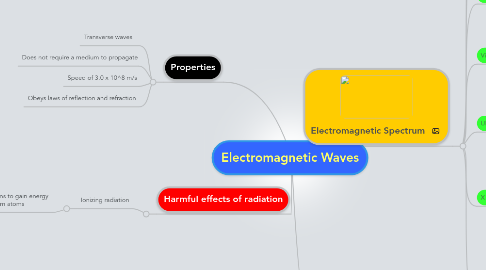
1. Properties
1.1. Transverse waves
1.2. Does not require a medium to propagate
1.3. Speed of 3.0 x 10^8 m/s
1.4. Obeys laws of reflection and refraction
2. Harmful effects of radiation
2.1. Ionizing radiation
2.1.1. Causes electrons to gain energy and escape from atoms
2.1.1.1. Atoms become charged and unstable
2.1.1.1.1. Initiate reactions and causes mutation in cells due to damaged DNA
2.1.1.1.2. Lead to cancer or faulty genetic material being passed down to offspring
3. Equations
3.1. c=λ/T
3.2. c=fλ
4. Electromagnetic Spectrum
4.1. Radio Waves
4.1.1. Has lowest frequency and longest wavelength
4.1.2. Uses: Radio and TV broadcasting
4.2. Microwaves
4.2.1. Radio waves with short wavelength
4.2.2. Uses: Heating up food (Microwave oven), transmission systems (satellites and radars)
4.3. Infared (IR)
4.3.1. Heat waves
4.3.2. Uses: Remote controls, Night vision equipment, Thermal imaging
4.4. Visible Light
4.4.1. Right light at low frequencies and violet light at high frequencies
4.4.2. Uses: Optical fibres, Light photography, Endoscopy
4.5. Ultra-violet rays (UV)
4.5.1. Excessive exposure can lead to sun burn and even skin cancer from DNA damage
4.5.2. Uses: Sun tanning, Aid in pollination, Checking for counterfeit notes
4.6. X rays
4.6.1. High frequencies and high penetrating capability through many materials
4.6.2. Hazardous
4.6.3. Uses: X-ray medical imaging, X-ray scanners
4.7. Gamma rays
4.7.1. Has the highest frequency
4.7.2. Most penetrating and highly ionizing form of electromagnetic waves
4.7.3. Hazardous
4.7.4. Uses: Treating cancer, Sterilising tools by killing bacteria and viruses
